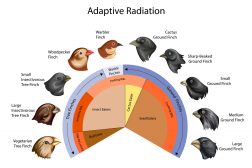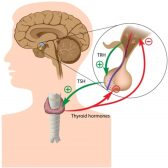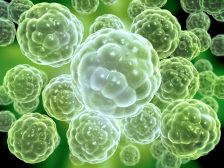The Evolutionary Development of Multicellular Organisms

An artist depiction of three “Opabinia regalis” animals hunting for prey on a reef of Cambrian Seas in the Paleozoic Era.
Table of Contents
The beginning of the Cambrian era saw a widespread arrival of multi-cellular organisms, particularly in the form of sponges. These species, who inhabited the Earth around half a billion years ago, could grow up to 1 meter across, making this distinctly different from the previous unicellular organisms.
This was the beginning of cell specialization into tissues, where particular tissues could perform functions to the well-being of the organism at large.
The interesting thing about specialization at the time is the fact that if you segregated the cells of these organisms, each cell could still live independently. This is a prolonged example in evolution where characteristics within organisms are similar to that of whole organisms, as in the mitochondria example mentioned at the foot of the previous page.
In fact, some multi-cellular species possess organelles that are indistinguishable from some species.
The accumulative induction of advantageous characteristics held by species was obviously being learned by the genome of other organisms, i.e. the permutations and advantages are common and widespread.
Sexual Reproduction
One major event in time is the development of sexual reproduction. Previous species method of reproduction was simply mitosis, repeated cell division which produced new organisms, and an exact copy of their ancestors. Of course, mutations and other factors over time changed their genome causing them to evolve.
But with sexual reproduction, genetic information is shared between organisms, meaning that the permutations involved in the long term involving the genome of species greatly increased. This is because of all the variances involved in meiosis meant that the possible genotype of offspring increased, and natural selection could take effect on the unique organisms.
Natural Selection Via Sex
Consider the following
- Previous life did not use sex as a means of reproduction
- They replicated making exact copies of themselves
- Genetic diversity was only increased by mutation and new chemical reactions occurring on Earth making simple proteins
- More modern organisms share genetic information by sexual reproduction
- 50% of genetic material is taken from each unique parent
- The offspring is unique, containing only 50% of genetic material from each parent, plus any change caused by natural selection and mutations
- Overall, diversity in the species is increased, causing differences, and thus selective advantages/advantages in comparison to one another within the species, and in relation to their environment
Due to the increased possibilities that life could diversify to with the advent of sex, genetic variation greatly increased and filled the ecosystem niches to a further extent. Competition for resources with species and against other organisms would be increasing in relation to past times, as populations increased and resources diminished.
In light of natural selection and ‘survival of the fittest‘, organisms would have to fight for their right to survive and be able to adapt fast enough to their environment to stand the test of time. In light of this predicament to life on Earth, further diversity continued, with the creation of distinct animals and plants arriving on the Earth’s surface…discussed more on the next tutorial of the timeline.
Draw Curiosity
You will also like...

Adaptive Radiation
The diversification of several new species from a recent ancestral source, each adapted to utilize or occupy a vacant ad..

The Origins of Life
This tutorial digs into the past to investigate the origins of life. The section is split into geological periods in the..

A Balanced Diet – Minerals and Proteins
Proteins and minerals can be derived from various dietary sources. They are essential for the proper growth and developm..

Hormone Production
Hormones are chemical messengers produced by specialized glands and they were produced by switching on the genes designe..

The Evolution of Cell Organelles
The nucleus containing the genetic material, DNA, and the mitochondria, well-identified as the "powerhouse of the cell",..

Growth and Development of a Human Baby
Upon fertilization, a zygote forms and develops into an embryo. This tutorial elaborates on the growth and development f..
